Glyphosate Herbicide Market Size
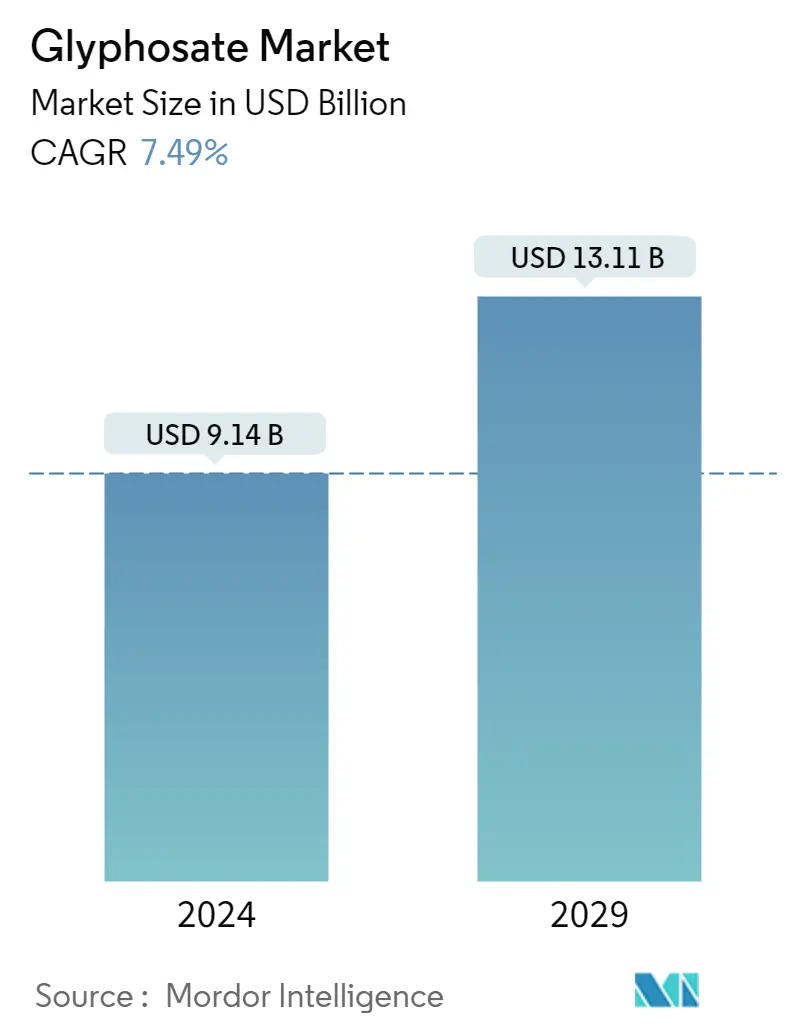
| Study Period | 2018 - 2029 |
| Market Size (2024) | USD 9.14 Billion |
| Market Size (2029) | USD 13.11 Billion |
| CAGR (2024 - 2029) | 7.49 % |
| Fastest Growing Market | North America |
| Largest Market | Asia Pacific |
Major Players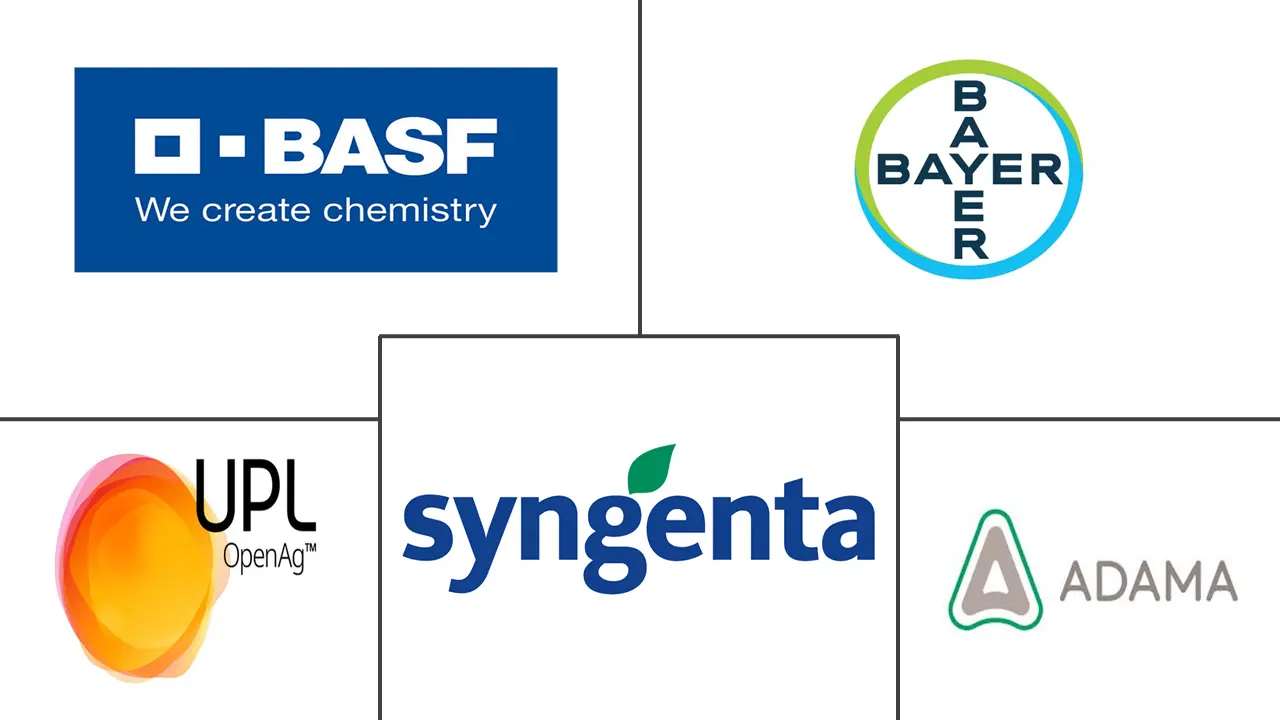
*Disclaimer: Major Players sorted in no particular order |
Glyphosate Herbicide Market Analysis
The Glyphosate Market size is estimated at USD 9.14 billion in 2024, and is expected to reach USD 13.11 billion by 2029, growing at a CAGR of 7.49% during the forecast period (2024-2029).
- With the area under herbicide-tolerant crops increasing and more countries approving herbicide-tolerance technology for crops, the market is expected to grow inorganically with rapid farmer adoption. Product advantages over mechanical tillage systems, like low cost, less soil, and environmental degradation, support the glyphosate market expansion. Its concerns for the environmental hazards remain in developed markets, but the market is not expected to slow down on account of the lack of availability of efficient alternatives to glyphosate.
- Most of the benefits conveyed to vegetable growers relate to glyphosate's versatility and flexibility. Glyphosate is registered for nearly all vegetable crops and can be used in most circumstances. The majority of glyphosate use, in terms of total acres treated, occurs during late postemergence to the crop in field crops. North America and Asia-Pacific are lucrative markets for glyphosate. GM crop adoption, coupled with arable land availability, is expected to drive the Asia Pacific glyphosate market over the coming years.
- Glyphosate is currently approved for use in the European Union until 15 December 2022. This means it can be used as an active substance in PPPs until that date, and each product is authorized by national authorities with a safety evaluation. European Food Safety Authority (EFSA) stated that it required more time to reassess the pesticide, pushing it back to July 2023.
- In 2022, The Indian government restricted the use of chemical glyphosate in India, fearing risks to human and animal health. However, the government allowed its use only through pest control operators (PCOs). PCOs are licensed to use deadly chemicals for treating pests such as rodents. Glyphosate and its formulations are widely registered and are currently used in over 160 countries, including the European Union and the United States.
Glyphosate Herbicide Market Trends
Commercialization of Genetically Engineered Herbicide-tolerant Crops
Herbicide-tolerant (HT) crops, which resist potent herbicides, provide farmers with various options for effective weed control. Also, the farmers do not need to till the soil, which they normally do to get rid of weeds. According to the USDA, genetically engineered herbicide-tolerant crops now account for about 56% of global glyphosate use. Genetically Engineered (GE) seeds were commercially introduced in the United States for major field crops, with adoption rates increasing rapidly. Over 90 percent of US corn, upland cotton, and soybeans are now produced using GE varieties. Herbicide-tolerant (HT) crops, which tolerate potent herbicides (such as glyphosate, glufosinate, and dicamba), provide farmers with a wide variety of options for effective weed control.
According to USDA survey data, in 2021 and 2022, soybean HT acreage increased slightly to 95 percent, and cotton reached a high of 94 percent in 2021. In 2022, approximately 90 percent of domestic corn acres were planted with HT seeds. No pesticide has come remotely close to such intensive and widespread use in the United States. Glyphosate may remain the most widely applied pesticide worldwide in the future, and its demand may grow in quantifying ecological and human health impacts.
With millions of acres planted, large field crops, such as soybeans, corn, cotton, and sugar beets, have the highest total area treated and pounds applied with glyphosate. On average, 84% of glyphosate, in terms of volume, is applied to soybeans, corn, or cotton per year. These three field crops have glyphosate-resistant (GR) varieties that have been widely adopted. The average single application rate for field crops ranges from 0.72 to 1.00 lbs. a.e./acre. Thus, glyphosate remains a useful herbicide for users in agricultural settings because of its nature of the broad-spectrum application, is simple to use, and is often cost-effective.
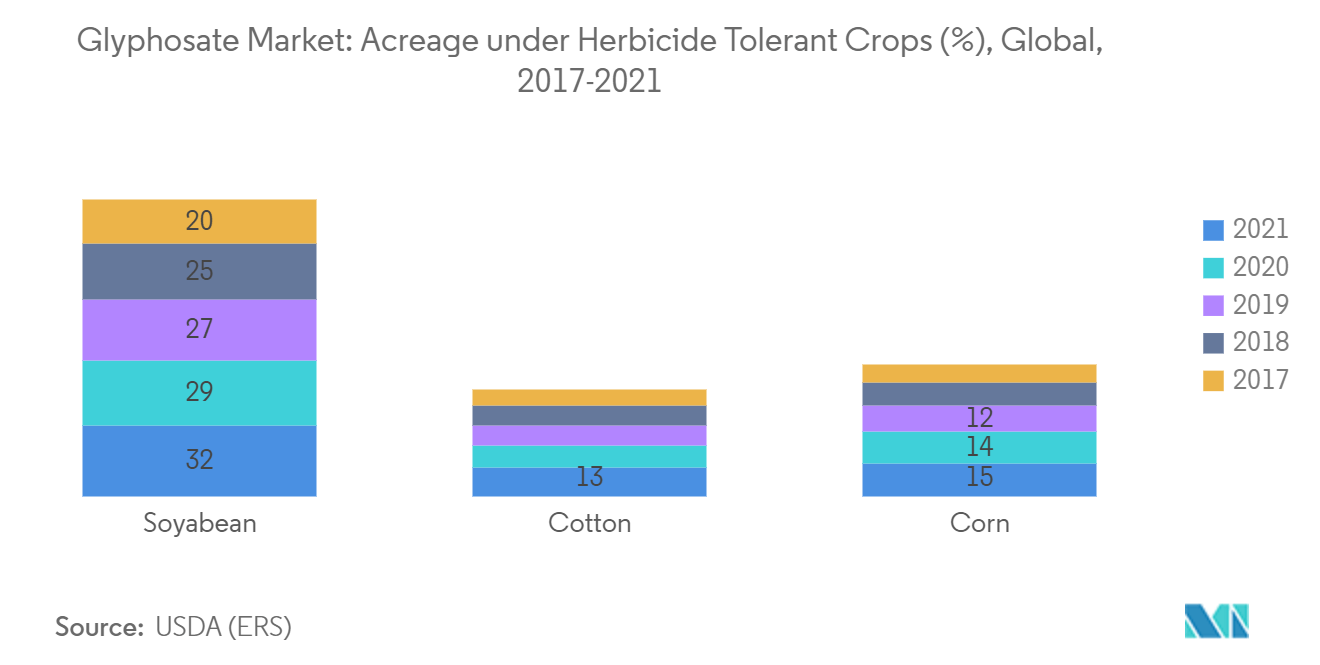
Asia-Pacific and North America are Potential Markets
The Asia-Pacific and the North American regions present equally attractive opportunities to companies operating in the glyphosate herbicide market. On account of the increasing levels of penetration of herbicide-tolerant hybrids, the North American region is expected to remain one of the largest markets for glyphosate. It is estimated that almost 56% of glyphosate usage in the United States is for herbicide-tolerant crops. GM crops are grown commercially in North America, including potato, squash/pumpkin, alfalfa, aubergine, sugar beet, papaya, rape oilseed, maize, soya beans, and cotton.
In the Asia-Pacific region, the market is expected to achieve faster growth. The region has the highest arable land in the world with the highest crop diversity. Increased adoption of advanced agricultural practices such as zero-tillage is expected to deliver growth to the glyphosate herbicide market in the region. However, China has provided approval to grow herbicide-tolerant hybrids.
GMO crops that are tolerant to herbicides help farmers control weeds without damaging the crops. For example, when the ringspot virus threatened the Hawaii papaya industry and the livelihoods of Hawaiian papaya farmers, plant scientists developed the ringspot virus-resistant Rainbow papaya called GMO papaya, which is resistant to a virus and now it is grown all over Hawaii and exported to Japan. In addition, Genetically modified (GM) crops can help reduce agricultural greenhouse gas (GHG) emissions and possible decreases in production emissions; GM yield gains also mitigate land-use change and related emissions.
Environment Ministry Approves the Cultivation of GM Mustard for those supporting commercial cultivation of GM crops, including greater food security due to increased yields, reduced costs for food production, reduced need for pesticides, and resistance to pests and disease. The transgenic mustard hybrid DMH-11 has been developed by the Centre for Genetic Manipulation of Crop Plants (CGMCP) in India. The government has so far approved only one GM crop, Bt cotton, for commercial cultivation.
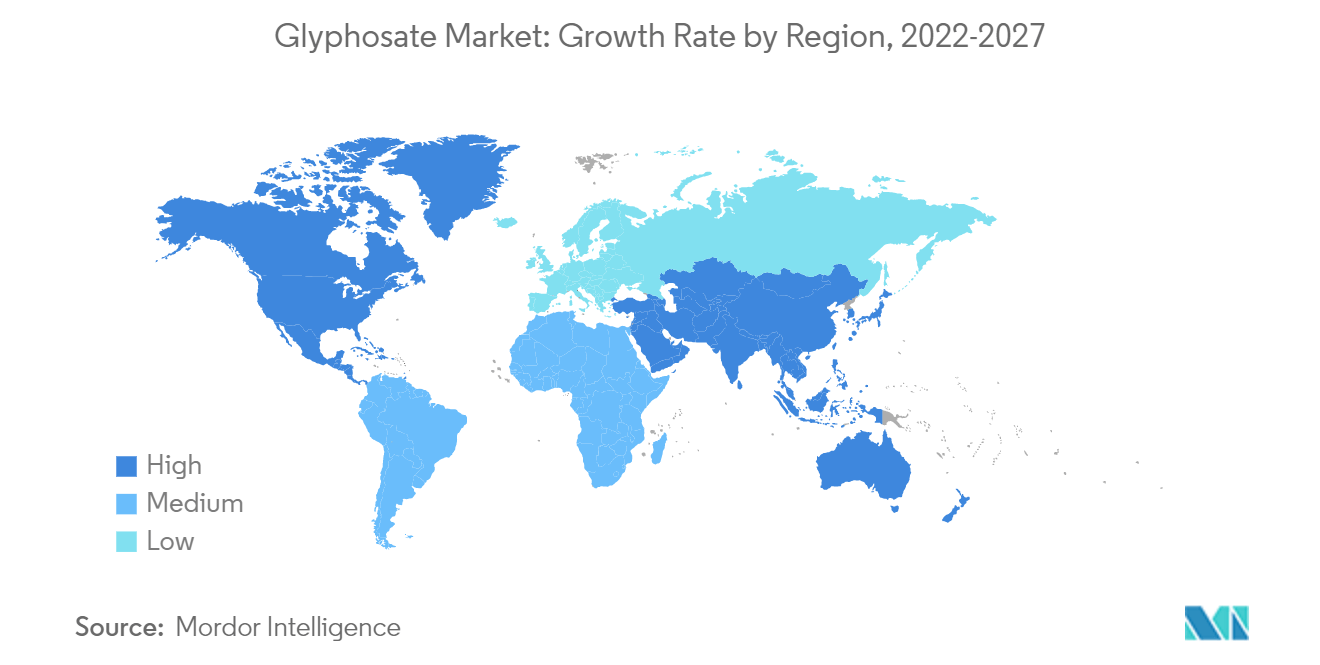
Glyphosate Herbicide Industry Overview
The global glyphosate market is consolidated with the dominance of players such as Bayer CropScience AG, BASF Corporation, Syngenta AG, Adama Agricultural Solutions Ltd, and UPL Limited. These companies are expanding their business activities by focusing on new product launches, partnerships, mergers, and acquisitions across the world.
Glyphosate Herbicide Market Leaders
-
Bayer Cropscience AG
-
Adama Agricultural Solutions Ltd
-
UPL Limited
-
BASF SE
-
Syngenta AG
*Disclaimer: Major Players sorted in no particular order
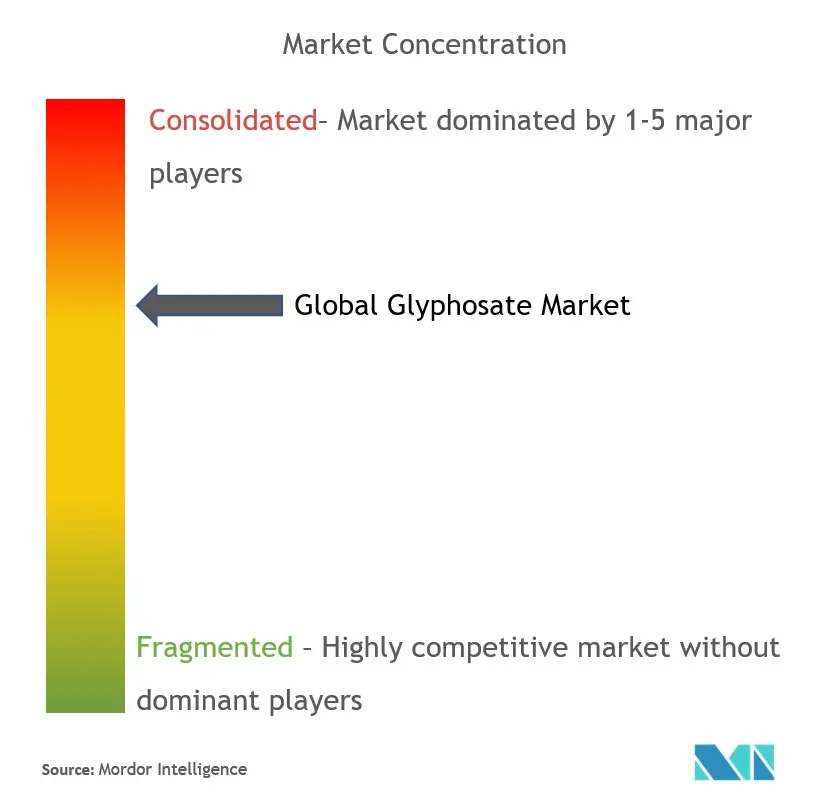
Glyphosate Herbicide Market News
- August 2022: BASF and Corteva Agriscience entered a collaboration deal to develop new soybean weed control solutions for farmers around the world, and the companies agreed to cross-license soybean traits while developing complementary herbicide technologies (which will include tolerance to glyphosate), enabling both companies to offer innovative soybean weed management solutions.
- January 2021: Syngenta launched a glyphosate product, the Kesuda isopropylamine salt of N-glycine 41%, in the Chinese market. The product is a breakthrough to the bottlenecks of conventional glyphosate of instability at low temperatures, slowing dying of weeds, and unthorough weeding. Kesuda is remarkably resistant to low temperatures, and the weeding effect is better than that of conventional products on the market.
Glyphosate Market Report - Table of Contents
1. INTRODUCTION
- 1.1 Study Assumptions and Market Definition
- 1.2 Scope of the Study
2. RESEARCH METHODOLOGY
3. EXECUTIVE SUMMARY
4. MARKET DYNAMICS
- 4.1 Market Overview
- 4.2 Market Drivers
- 4.3 Market Restraints
-
4.4 Porter's Five Forces Analysis
- 4.4.1 Bargaining Power of Suppliers
- 4.4.2 Bargaining Power of Buyers
- 4.4.3 Threat of New Entrants
- 4.4.4 Threat of Substitute Products
- 4.4.5 Intensity of Competitive Rivalry
5. MARKET SEGMENTATION
-
5.1 Type
- 5.1.1 GM Crops
- 5.1.2 Non-GM Crops
-
5.2 Application
- 5.2.1 Grains and Cereals
- 5.2.2 Pulses and Oilseeds
- 5.2.3 Fruits and Vegetables
- 5.2.4 Commercial Crops
- 5.2.5 Other Crop Types
-
5.3 Geography
- 5.3.1 North America
- 5.3.1.1 United States
- 5.3.1.2 Canada
- 5.3.1.3 Mexico
- 5.3.1.4 Rest of North America
- 5.3.2 Europe
- 5.3.2.1 Spain
- 5.3.2.2 Italy
- 5.3.2.3 France
- 5.3.2.4 Germany
- 5.3.2.5 Russia
- 5.3.2.6 United Kingdom
- 5.3.2.7 Rest of Europe
- 5.3.3 Asia-Pacific
- 5.3.3.1 India
- 5.3.3.2 China
- 5.3.3.3 Japan
- 5.3.3.4 Australia
- 5.3.3.5 Rest of Asia-Pacific
- 5.3.4 South America
- 5.3.4.1 Brazil
- 5.3.4.2 Argentina
- 5.3.4.3 Rest of South America
- 5.3.5 Africa
- 5.3.5.1 South Africa
- 5.3.5.2 Rest of Africa
6. COMPETITIVE LANDSCAPE
- 6.1 Most Adopted Strategies
- 6.2 Market Share Analysis
-
6.3 Company Profiles
- 6.3.1 Adama Agricultural Solutions Ltd
- 6.3.2 BASF SE
- 6.3.3 Bayer Cropscience AG
- 6.3.4 UPL Limited
- 6.3.5 FMC Corporation
- 6.3.6 Zhejiang Xinan Chemical Industrial Group Company Ltd
- 6.3.7 Nufarm Limited
- 6.3.8 DuPont
- 6.3.9 Syngenta International
- 6.3.10 Dow AgroSciences
- *List Not Exhaustive
7. MARKET OPPORTUNITIES AND FUTURE TRENDS
** Subject To AvailablityGlyphosate Herbicide Industry Segmentation
Glyphosate is one of the most commonly used herbicides. It is classified as a post-emergent, non-selective, systemic herbicide capable of killing weeds that have green foliage.
The global glyphosate market is segmented by type (gm crops and non-gm crops), application (grains and cereals, pulses and oilseeds, fruits and vegetables, commercial crops, and other crop types), and geography (North America, South America, Europe, Asia-Pacific, and Africa). The report also covers the market size and forecasts for the glyphosate market across the world. For each segment, the market size and forecasts will be provided in terms of value (USD million).
| Type | GM Crops | |
| Non-GM Crops | ||
| Application | Grains and Cereals | |
| Pulses and Oilseeds | ||
| Fruits and Vegetables | ||
| Commercial Crops | ||
| Other Crop Types | ||
| Geography | North America | United States |
| Canada | ||
| Mexico | ||
| Rest of North America | ||
| Geography | Europe | Spain |
| Italy | ||
| France | ||
| Germany | ||
| Russia | ||
| United Kingdom | ||
| Rest of Europe | ||
| Geography | Asia-Pacific | India |
| China | ||
| Japan | ||
| Australia | ||
| Rest of Asia-Pacific | ||
| Geography | South America | Brazil |
| Argentina | ||
| Rest of South America | ||
| Geography | Africa | South Africa |
| Rest of Africa |
Glyphosate Market Research Faqs
How big is the Glyphosate Market?
The Glyphosate Market size is expected to reach USD 9.14 billion in 2024 and grow at a CAGR of 7.49% to reach USD 13.11 billion by 2029.
What is the current Glyphosate Market size?
In 2024, the Glyphosate Market size is expected to reach USD 9.14 billion.
Who are the key players in Glyphosate Market?
Bayer Cropscience AG, Adama Agricultural Solutions Ltd, UPL Limited, BASF SE and Syngenta AG are the major companies operating in the Glyphosate Market.
Which is the fastest growing region in Glyphosate Market?
North America is estimated to grow at the highest CAGR over the forecast period (2024-2029).
Which region has the biggest share in Glyphosate Market?
In 2024, the Asia Pacific accounts for the largest market share in Glyphosate Market.
What years does this Glyphosate Market cover, and what was the market size in 2023?
In 2023, the Glyphosate Market size was estimated at USD 8.5 billion. The report covers the Glyphosate Market historical market size for years: 2018, 2019, 2020, 2021, 2022 and 2023. The report also forecasts the Glyphosate Market size for years: 2024, 2025, 2026, 2027, 2028 and 2029.
Glyphosate Industry Report
Statistics for the 2024 Glyphosate market share, size and revenue growth rate, created by Mordor Intelligence™ Industry Reports. Glyphosate analysis includes a market forecast outlook to for 2024 to 2029 and historical overview. Get a sample of this industry analysis as a free report PDF download.



